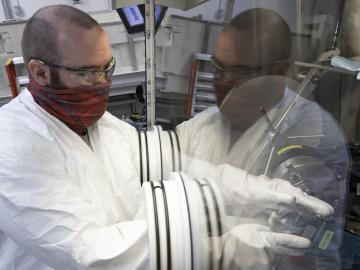
Filter News
Area of Research
- (-) Isotopes (10)
- (-) Supercomputing (68)
- Advanced Manufacturing (22)
- Biological Systems (1)
- Biology and Environment (45)
- Biology and Soft Matter (1)
- Building Technologies (1)
- Computational Biology (2)
- Computational Engineering (2)
- Computer Science (7)
- Electricity and Smart Grid (1)
- Energy Science (103)
- Functional Materials for Energy (1)
- Fusion and Fission (10)
- Fusion Energy (1)
- Isotope Development and Production (1)
- Materials (64)
- Materials for Computing (9)
- National Security (20)
- Neutron Science (27)
- Nuclear Science and Technology (15)
News Topics
- (-) 3-D Printing/Advanced Manufacturing (5)
- (-) Artificial Intelligence (37)
- (-) Big Data (22)
- (-) Biomedical (23)
- (-) Chemical Sciences (5)
- (-) Molten Salt (1)
- (-) Space Exploration (6)
- Advanced Reactors (1)
- Bioenergy (9)
- Biology (11)
- Biotechnology (2)
- Buildings (4)
- Computer Science (96)
- Coronavirus (14)
- Critical Materials (3)
- Cybersecurity (8)
- Energy Storage (9)
- Environment (23)
- Exascale Computing (26)
- Frontier (32)
- Fusion (1)
- Grid (5)
- High-Performance Computing (43)
- Irradiation (1)
- Isotopes (27)
- Machine Learning (15)
- Materials (19)
- Materials Science (17)
- Mathematics (2)
- Microscopy (7)
- Nanotechnology (11)
- National Security (9)
- Neutron Science (13)
- Nuclear Energy (7)
- Partnerships (1)
- Physics (8)
- Polymers (2)
- Quantum Computing (20)
- Quantum Science (25)
- Security (6)
- Simulation (16)
- Software (1)
- Summit (43)
- Transportation (6)
Media Contacts

The Department of Energy’s Oak Ridge National Laboratory has licensed its award-winning artificial intelligence software system, the Multinode Evolutionary Neural Networks for Deep Learning, to General Motors for use in vehicle technology and design.

A rare isotope in high demand for treating cancer is now more available to pharmaceutical companies developing and testing new drugs.

Twenty-seven ORNL researchers Zoomed into 11 middle schools across Tennessee during the annual Engineers Week in February. East Tennessee schools throughout Oak Ridge and Roane, Sevier, Blount and Loudon counties participated, with three West Tennessee schools joining in.

On Feb. 18, the world will be watching as NASA’s Perseverance rover makes its final descent into Jezero Crater on the surface of Mars. Mars 2020 is the first NASA mission that uses plutonium-238 produced at the Department of Energy’s Oak Ridge National Laboratory.

A better way of welding targets for Oak Ridge National Laboratory’s plutonium-238 production has sped up the process and improved consistency and efficiency. This advancement will ultimately benefit the lab’s goal to make enough Pu-238 – the isotope that powers NASA’s deep space missions – to yield 1.5 kilograms of plutonium oxide annually by 2026.

Six scientists at the Department of Energy’s Oak Ridge National Laboratory were named Battelle Distinguished Inventors, in recognition of obtaining 14 or more patents during their careers at the lab.

The annual Director's Awards recognized four individuals and teams including awards for leadership in quantum simulation development and application on high-performance computing platforms, and revolutionary advancements in the area of microbial

A multi-institutional team, led by a group of investigators at Oak Ridge National Laboratory, has been studying various SARS-CoV-2 protein targets, including the virus’s main protease. The feat has earned the team a finalist nomination for the Association of Computing Machinery, or ACM, Gordon Bell Special Prize for High Performance Computing-Based COVID-19 Research.

ORNL and three partnering institutions have received $4.2 million over three years to apply artificial intelligence to the advancement of complex systems in which human decision making could be enhanced via technology.

Scientists from Oak Ridge National Laboratory used high-performance computing to create protein models that helped reveal how the outer membrane is tethered to the cell membrane in certain bacteria.


